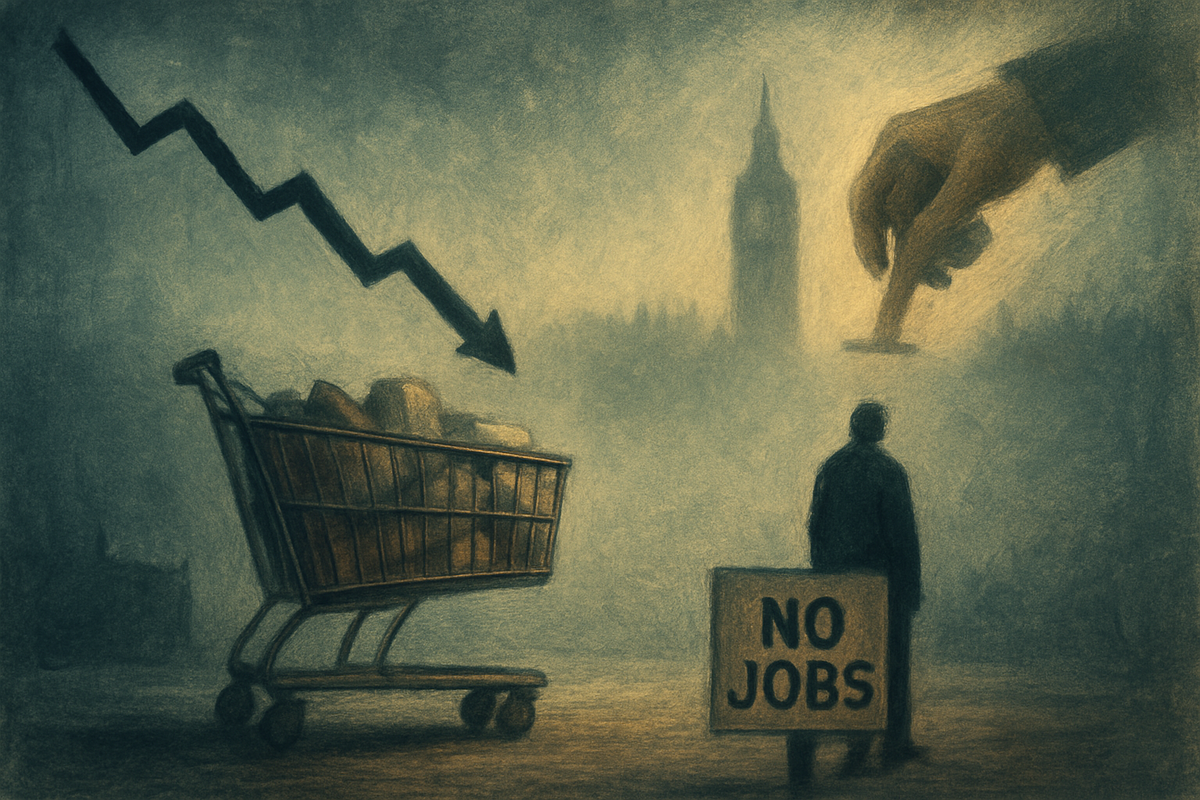
Britain's economy is navigating a treacherous landscape of slowing growth, stubbornly elevated inflation, and a rising tide of unemployment, casting a long shadow over its future prospects. As the nation inches closer to the pivotal autumn Budget on November 26, 2025, pressure is mounting on the government to unveil robust economic stimulus measures to avert a deeper downturn and reignite confidence in a faltering market. These intertwined challenges threaten to exacerbate an already fragile economic environment, prompting urgent calls for strategic interventions to stabilize the economy and support struggling households and businesses.
The confluence of these adverse indicators signals a critical juncture for the UK. With economic output barely expanding, consumer prices remaining stubbornly high, and the labor market showing clear signs of stress, the immediate implications are profound. Fears of a potential recession are intensifying, while the Bank of England faces a delicate balancing act between taming inflation and stimulating growth. All eyes are now on Chancellor Rachel Reeves, who is expected to deliver a Budget that not only addresses a significant fiscal shortfall but also charts a credible path towards economic recovery amidst a climate of widespread uncertainty.
Economic Headwinds Intensify Ahead of Crucial Autumn Budget
The current economic predicament in the UK has been building throughout 2025, with recent data painting a stark picture of deceleration. Real Gross Domestic Product (GDP) growth slowed significantly, registering a mere 0.1% increase in the third quarter (July to September), a sharp decline from 0.3% in Q2 and 0.7% in Q1. This underperformance was further highlighted by a 0.1% contraction in monthly GDP in September, partly attributed to a cyber-attack on car manufacturer Jaguar Land Rover (JLR), which severely impacted the production sector. The services sector, the backbone of the UK economy, also saw its growth falter, while real GDP per head remained stagnant, underscoring a standstill in living standards.
Inflation, despite a series of interest rate hikes by the Bank of England, remains a persistent concern. The annual Consumer Prices Index (CPI) inflation rate stood at 3.8% in September 2025, nearly double the central bank's 2% target. While some forecasts suggest a slight moderation in October, core inflation (excluding volatile items) and services inflation continue to run hot at 3.5% and 4.7% respectively. This sustained inflationary pressure has forced the Bank of England to maintain its core interest rate at 4% in early November, a decision reflecting the ongoing struggle to balance price stability with weakening economic activity.
Compounding these issues, the UK labour market has shown worrying signs of deterioration. The unemployment rate climbed to 5.0% in the three months to September 2025, marking its highest level since February 2021 and surpassing analyst expectations. This rise in joblessness was accompanied by a decrease in the employment rate and a significant annual decline in payrolled employment, with 32,000 fewer people on payrolls in October. Although average regular earnings growth is still outpacing inflation, its deceleration signals a softening in wage pressures. These combined factors – slowing growth, entrenched inflation, and a weakening job market – have collectively battered business and consumer confidence, leading to reduced investment and strained household incomes. In response to the latest disappointing GDP figures, Pound Sterling has also shown weakness, reflecting broader market anxieties.
The upcoming autumn Budget, scheduled for November 26, 2025, is therefore anticipated with heightened expectation. Chancellor Rachel Reeves faces the unenviable task of navigating a substantial fiscal shortfall, estimated by the independent Office for Budget Responsibility (OBR) to be around £30 billion. While further tax rises, potentially targeting Inheritance Tax, Capital Gains Tax, and dividend tax rates, are widely expected to plug this gap, there is a delicate balance to strike. Experts caution that aggressive fiscal tightening could further stifle economic activity and potentially tip the economy into recession. Consequently, the government is under immense pressure to introduce targeted measures that not only address the deficit but also stimulate growth, alleviate cost pressures, and restore confidence, potentially through support for investment and reconsideration of employer costs.
Companies Navigate Turbulent Waters: Potential Winners and Losers in a Strained Economy
The prevailing economic headwinds of slowing growth, persistent inflation, and rising unemployment are creating a challenging environment for UK public companies, forcing strategic re-evaluations and sharpening the divide between potential winners and losers. The anticipated economic stimulus and policy adjustments in the upcoming autumn Budget on November 26, 2025, are poised to further shape the fortunes of various sectors.
Housebuilders are among those expected to find some relief and potentially emerge as winners. This sector is highly sensitive to interest rates, with elevated mortgage rates having previously dampened demand and property price growth. The growing expectation of further interest rate cuts by the Bank of England, possibly reaching 3.5% or lower by early 2026, is a significant positive. Lower borrowing costs would improve mortgage affordability and stimulate housing market activity, and reduce the financial burden on developers. Companies like Barratt Developments Plc (LSE: BDEV), Persimmon Plc (LSE: PSN), Taylor Wimpey Plc (LSE: TW), Berkeley Group Holdings Plc (LSE: BKG), Vistry Group Plc (LSE: VTY), and Bellway Plc (LSE: BWY) could see renewed buyer interest and improved profitability.
Similarly, supermarkets and discount retailers are generally more resilient in an inflationary environment with squeezed consumer spending. As households tighten their belts, they prioritize essential goods and seek value, shifting expenditure away from discretionary items. This trend typically benefits grocery chains and value-oriented retailers. Key players such as Tesco Plc (LSE: TSCO), J Sainsbury Plc (LSE: SBRY), and B&M European Value Retail S.A. (LSE: BME) are well-positioned to maintain, or even grow, their market share. Even Marks & Spencer Group Plc (LSE: MKS), particularly its robust food division, could demonstrate resilience. Furthermore, utility companies like National Grid Plc (LSE: NG), Severn Trent Plc (LSE: SVT), and SSE Plc (LSE: SSE) could benefit from lower interest rates, which would reduce their significant borrowing costs and potentially boost earnings. The UK's technology sector, which has consistently driven economic growth, is also likely to receive continued government support through strategic investment and skill development, underpinning its long-term potential.
Conversely, sectors heavily reliant on discretionary consumer spending are likely to face continued pressure. Discretionary retailers, particularly those selling non-essential goods like clothing, home furnishings, and DIY products, are vulnerable. With consumer confidence low, real incomes squeezed by inflation, and unemployment rising, households are cutting back on non-essential purchases. Companies such as Next Plc (LSE: NXT), Kingfisher Plc (LSE: KGF) (owner of B&Q and Screwfix), and Wickes Group Plc (LSE: WIX) are likely to experience reduced demand. Online fashion retailers like ASOS Plc (LSE: ASC) and Boohoo Group Plc (LSE: BOO) also face intense competition and are susceptible to a decline in youth spending.
The hospitality sector is another area facing significant headwinds. Pubs, restaurants, and hotels are grappling with a dual challenge: soaring operating costs (energy, food, and increased labor expenses due to National Insurance and minimum wage hikes) and a marked reduction in consumer spending on leisure and dining out. Many businesses in this sector are struggling to remain profitable, leading to closures and job losses. Without substantial targeted intervention, companies like Mitchells & Butlers Plc (LSE: MAB) and JD Wetherspoon Plc (LSE: JDW) face a challenging outlook. While Whitbread Plc (LSE: WTB), with its diversified model including Premier Inn, might show more resilience, the broader sector remains highly exposed. Finally, the financial services sector, while potentially benefiting from lower interest rates in some areas, faces the risk of specific tax hikes. Speculation around the autumn Budget includes potential increases in the bank surcharge or making interest on funds held by commercial banks at the Bank of England taxable, which could impact the profitability of major institutions like Lloyds Banking Group Plc (LSE: LLOY), NatWest Group Plc (LSE: NWG), Barclays Plc (LSE: BARC), and HSBC Holdings Plc (LSE: HSBA).
The specific details of the autumn Budget's tax reforms and spending plans will be paramount in determining the ultimate impact on corporate profitability and investment decisions across these varied sectors.
Broader Implications: A Nation at a Crossroads
Britain's current economic predicament transcends immediate fiscal concerns, fitting into broader global and historical trends that underscore the gravity of the situation. The confluence of slowing growth, persistent inflation, and rising unemployment is not an isolated event but rather a reflection of interconnected global instabilities, long-standing domestic challenges, and the ongoing repercussions of significant policy shifts.
Globally, the UK's struggles are deeply intertwined with the lingering effects of the COVID-19 pandemic, the geopolitical fallout from the war in Ukraine and its impact on energy prices, and persistent supply chain disruptions. These external shocks have exacerbated internal vulnerabilities, contributing to the elevated inflation seen across many advanced economies. Domestically, a persistent "productivity puzzle" has plagued the UK since the 2007-2009 financial crisis, with labor productivity growth significantly decelerating. This long-term issue severely limits improvements in living standards and the overall growth potential of the economy. Furthermore, the economic impact of Brexit continues to shape the landscape, leading to trade disruptions with the EU, increased operational costs, and shifts in consumer and business behavior, estimated to have cost the UK £27 billion in the initial two years post-departure. In response, UK businesses are increasingly diversifying supply networks and investing in digital transformation and sustainable practices to adapt to these new realities. The nation also faces a mounting public debt, projected to rise to 106.4% of GDP in 2025, which poses a growing vulnerability.
The ripple effects of a weakening UK economy extend significantly to its international partners, particularly within the Eurozone, a major trading bloc. A depreciating Pound Sterling, while potentially making UK exports more competitive, simultaneously increases the cost of imports for British buyers, potentially impacting Eurozone exporters and contributing to inflationary pressures within the UK. The long-term effects of Brexit on trade and supply chains are cited as having "devastating" ripple effects across Europe. Beyond Europe, the UK's economic health serves as a barometer for the broader global challenge of central banks attempting to balance inflation control with economic growth, often amidst paradoxical labor market conditions. The UK's ability to navigate trade friction with the EU and potential future tariffs from a new US administration will be crucial for its future growth trajectory.
Beyond the immediate autumn Budget, the current economic climate is shaping significant regulatory and policy directions. The downbeat labor market data has intensified calls for the Bank of England to ease its monetary policy, with market expectations pointing towards an interest rate cut as early as December 2025, potentially supporting business investment. Maintaining fiscal credibility is paramount for the government, especially as the Office for Budget Responsibility (OBR) is expected to downgrade medium-term growth forecasts, which may necessitate further tax increases or spending cuts to meet stated fiscal rules. There is a recognized need for a long-term growth strategy that moves beyond immediate measures, addressing systemic issues like low investment, policy uncertainty, and stagnant productivity. Evolving trade policy, balancing established EU ties with ambitious global engagements, and carefully designing inclusive policies for the green transition are also critical challenges.
Historically, the UK's current struggles draw parallels with several challenging periods. The slow growth post-2008 financial crisis mirrors previous periods of stagnation. More strikingly, the combination of high inflation, rising unemployment, and fiscal pressures echoes the 1976 IMF crisis, which necessitated drastic public spending cuts and led to widespread social discontent. Comparisons can also be drawn to the 1931 devaluation crisis and the 1992 ERM crisis, both demonstrating the pressures faced when economic fundamentals are misaligned with policy. In a contemporary context, the UK's post-pandemic recovery has been notably weaker than that of the US and the Eurozone, leading some experts to suggest it could be "first to enter a recession, and the last one to pull out" among major economies. The present "stagflationary environment" with high inflation and unprecedentedly slow GDP per capita growth since World War II highlights the unique severity of the current situation.
What Comes Next: Navigating the Path to Recovery
The immediate and long-term trajectory of the UK economy hinges critically on the outcomes of the autumn Budget on November 26, 2025, and the subsequent policy responses from both fiscal and monetary authorities. As Britain grapples with its current economic challenges, businesses and the government alike are poised for strategic pivots to navigate a path toward stability and sustainable growth.
In the short-term, the economy is likely to experience continued subdued growth. The anticipated fiscal tightening in the Budget, aimed at addressing the substantial fiscal shortfall, is expected to further dampen GDP growth into 2026. While inflation is projected to gradually ease, potentially returning to the Bank of England's 2% target by late 2026, it is expected to remain elevated in the fourth quarter of 2025. The Bank of England is likely to maintain interest rates at 4% for the remainder of 2025 due to persistent inflationary pressures. However, if inflation tumbles more rapidly, rate cuts to 3.5% or even 3% by late 2026 are within the realm of possibility, offering some relief. Concurrently, the unemployment rate is forecast to continue its upward trend, potentially peaking at just over 5% in the first half of 2026 before a gradual decline. This period will demand heightened vigilance from businesses, requiring agile responses to fluctuating consumer demand and operational costs.
Looking at the long-term possibilities, sustained economic growth beyond 2026 will heavily rely on strengthening private consumption and investment, alongside significant improvements in productivity. The Office for Budget Responsibility's (OBR) expected downgrade of long-term productivity forecasts underscores the magnitude of this challenge. Structurally, the UK's commitment to transitioning to a low-carbon economy, with substantial investments in green technologies, renewable energy, and sustainable infrastructure, is expected to create new industries and employment opportunities, positioning the nation as a leader in sustainability. Global trade dynamics, including the ongoing adjustments post-Brexit and the pursuit of new trade agreements (e.g., with India and potentially the US), will also continue to shape the UK's economic future. The thriving tech sector, particularly in fintech, AI, and cybersecurity, is anticipated to be a significant growth engine, with digital transformation and AI adoption crucial for enhancing business efficiency and competitiveness.
Strategic pivots and adaptations will be paramount for both businesses and the government. Businesses are already focusing on building resilience through diversifying revenue streams and supply chains, investing in logistics technology, and developing robust contingency plans. Embracing sustainable practices and leveraging digital transformation, especially AI, are becoming critical for competitiveness. Workforce strategies will adapt to economic policy changes like rising National Insurance contributions and the National Living Wage, potentially involving automation and flexible work arrangements. For the government, the delicate task involves balancing fiscal consolidation with growth-oriented reforms. A revamped industrial strategy focused on key growth-driving sectors, coupled with an agile trade policy, and continued investment in digital and green infrastructure, alongside initiatives to address skills shortages, are vital for long-term prosperity.
Market opportunities are likely to emerge in the tech and green sectors, where the UK holds a strong position. The nation is also projected to extend its lead as the second-largest services exporter globally, with finance, insurance, and business services being major contributors. Public-private investment in transport, energy, and housing infrastructure, alongside a focus on digital project management and low-carbon building, presents opportunities in the construction sector. Conversely, challenges include persistent economic uncertainty, weak domestic demand, and high costs from elevated labor, material, and energy prices. Brexit-related trade barriers and potential US tariffs add further uncertainty, while the government's limited fiscal flexibility restricts its ability to provide substantial stimulus.
Several potential scenarios and outcomes could unfold. A necessary fiscal consolidation, while aiming for long-term stability, could lead to slower growth in the short to medium term, with a risk of negative market reactions to aggressive tax hikes. Alternatively, a gradual recovery could be fostered by monetary support, with more aggressive interest rate cuts by the Bank of England in 2026 providing stimulus to investment and consumption if inflation eases. The UK might also see a "two-speed economy," with services potentially outperforming manufacturing and construction, and London remaining a strong economic engine while other regions specialize. Ultimately, despite the immediate challenges, a strong focus on innovation, particularly in tech and green sectors, coupled with strategic adaptations by businesses and targeted government investments, could enable the UK to emerge stronger and more dynamic in the long run.
Comprehensive Wrap-up: A Test of Resilience and Strategic Acumen
Britain's economy stands at a critical juncture, facing a complex interplay of slowing growth, persistent inflation, and rising unemployment that demands decisive action and strategic foresight. The upcoming autumn Budget on November 26, 2025, represents a pivotal moment, expected to lay out the government's plan to navigate these turbulent waters and chart a course towards recovery. The challenges are significant, but so too are the opportunities for a nation poised to leverage its strengths in innovation and strategic adaptation.
The key takeaways from the current economic landscape are clear: the UK is in a period of pronounced economic fragility, marked by a deceleration in GDP growth, stubbornly high inflation well above the Bank of England's target, and a weakening labor market. These domestic issues are exacerbated by global instabilities and the ongoing economic adjustments post-Brexit. The immediate implication is mounting pressure on the government to deliver a Budget that not only addresses a significant fiscal shortfall through likely tax increases but also provides targeted stimulus to foster growth and restore confidence. The Bank of England, having held interest rates steady, is increasingly expected to pivot towards cuts in 2026 if inflation shows sustained signs of easing, providing potential monetary relief.
Moving forward, the market will be closely watching for the specific details of the Budget, particularly the balance between fiscal consolidation and growth-oriented measures. Sectors such as housebuilders and essential retailers may find some respite from anticipated interest rate cuts and shifts in consumer behavior, while discretionary retailers and the hospitality sector face continued headwinds. The long-term health of the economy will depend on improvements in productivity, strategic investments in green and digital infrastructure, and an agile approach to global trade. Businesses are already adapting by focusing on resilience, diversification, digitalization, and sustainability, while the government is tasked with fostering an environment conducive to investment and innovation.
For investors, the coming months will require careful consideration of these evolving dynamics. Key indicators to watch include the specific tax and spending measures announced in the autumn Budget, subsequent economic data releases (especially on inflation and employment), and any shifts in the Bank of England's monetary policy. Opportunities may lie in resilient sectors, technology, and green industries, while caution is advised for highly discretionary consumer segments. The UK's ability to overcome its "productivity puzzle" and effectively balance fiscal prudence with growth-enhancing policies will ultimately determine its long-term economic trajectory and lasting impact on global financial markets.
This content is intended for informational purposes only and is not financial advice






